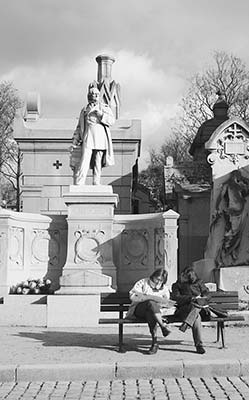
Cimetière du Père Lachaise
Map: Père Lachaise Cemetery Tour
6 Bernard Verlhac (pseudonym Tignous, 1957-2015)
10 Baron Georges-Eugène Haussmann (1809-1891)
11 Gioacchino Rossini (1792-1868)
Enclosed by a massive wall and lined with 5,000 trees, the peaceful, car-free lanes and dirt paths of Père Lachaise cemetery encourage parklike meandering. Named for Father (Père) La Chaise, whose job was listening to Louis XIV’s sins, the cemetery is relatively new, having opened in 1804 to accommodate Paris’ expansion. Today, this city of the dead (pop. 70,000) still accepts new residents, but real estate prices are sky high (a 21-square-foot plot costs more than €11,000).
The 100-acre cemetery is big and confusing, with thousands of graves and tombs crammed every which way, and only a few pedestrian pathways to help you navigate. The maps available from a nearby florist can help guide your way (see below), but you’re better off taking my tour as you play grave-hunt with the cemetery’s other visitors. This walk takes you on a one-way tour between two convenient Métro/bus stops (Gambetta and Père Lachaise), connecting a handful of graves from some of this necropolis’ best-known residents.
(See “Père Lachaise Cemetery Tour” map, here.)
Cost: Free.
Hours: Mon-Fri 8:00-18:00, Sat 8:30-18:00, Sun 9:00-18:00, until 17:30 in winter.
Getting There: Take bus #69 eastbound to the end of the line at Place Gambetta (see the Bus #69 Sightseeing Tour chapter), or ride the Métro to the Gambetta stop (not to the Père Lachaise stop), exit at Gambetta Métro, and take sortie #3 (Père Lachaise exit). From Place Gambetta, it’s a two-block walk past McDonald’s and up Avenue du Père Lachaise to the cemetery.
Information: Maps are sold at J Poulain & Fils, a florist across from the Porte Gambetta entrance (about €2). An unofficial website, www.pere-lachaise.com, has a searchable map (tel. 01 55 25 82 10).
Length of This Tour: Allow 1.5 hours for this walk and another 30 minutes for your own detours. Bring good walking shoes for the rough, cobbled streets.
Tours:  Download my Père Lachaise Cemetery audio tour (planned to release in 2018).
Download my Père Lachaise Cemetery audio tour (planned to release in 2018).
Services: WCs are at the start of this tour, just inside the Porte Gambetta entrance (up to the right), and at the end of this tour, to the right just before you exit Porte Principale.
Eating: You’ll pass several cafés and a small grocery shop between Place Gambetta and the cemetery. After the tour, you can walk downhill from the cemetery on Rue de la Roquette to a gaggle of lively, affordable cafés on the right side of the street, near the return stop for bus #69.
Starring: Oscar Wilde, Edith Piaf, Gertrude Stein, Molière, Jim Morrison, Frédéric Chopin, Colette, and Rossini.
From the Porte Gambetta entrance, we’ll walk roughly southwest (mostly downhill) through the cemetery. At the end of the tour, we’ll exit Porte Principale onto Boulevard de Ménilmontant, near the Père Lachaise Métro entrance and another bus #69 stop. (You could follow the tour heading the other direction, but it’s not recommended—it’s confusing, and almost completely uphill.)
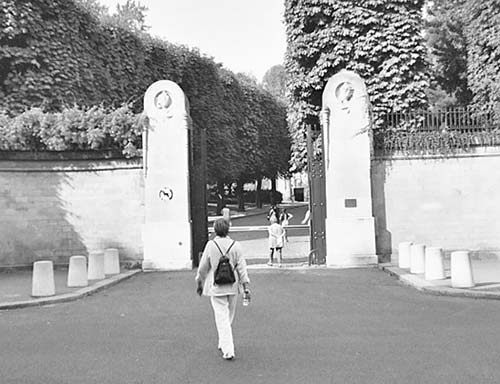
Refer to the map on here, and follow street signs posted at intersections. The layout of the cemetery makes an easy-to-follow tour impossible. It’s a little easier if you buy a more detailed map to use along with our rather general one. Be patient, make a few discoveries of your own, and ask passersby for graves you can’t locate.
(See “Père Lachaise Cemetery Tour” map, here.)
• Entering the cemetery at the Porte Gambetta entrance, walk straight up Avenue des Combattants Etrangers past world war memorials dedicated to foreigners who fought for France: Armenians, Poles, Italians, and Russians. Cross Avenue Transversale No. 3, pass the first building, and look left to the...
Marked by a dome with a gilded flame and working chimneys on top, the columbarium sits in a courtyard surrounded by about 1,300 niches—small cubicles for cremated remains, often decorated with real or artificial flowers.
Beneath the courtyard (steps leading underground) are about 12,000 smaller niches, including one for Maria Callas (1923-1977), an American-born opera diva known for her versatility, flair for drama, and affair with Aristotle Onassis (niche #16258, on the immediate left, 20 yards down aisle J).
• Turn around and walk back to the intersection with Avenue Transversale No. 3. (Note how families built small chapels for several generations of loved ones to share.) Turn right, heading southeast on the avenue, turn left on Avenue Carette, and walk half a block to the block-of-stone tomb (on the left) with heavy-winged angels trying to fly.
The writer and martyr to homosexuality is mourned by “outcast men” (as the inscription says) and by wearers of heavy lipstick, who used to cover the tomb and the angels’ emasculated privates with kisses. (Now the tomb is behind glass, which has not stopped committed kissers.) Despite Wilde’s notoriety, an inscription says, “He died fortified by the Sacraments of the Church.” There’s a short résumé scratched (in English) into the back side of the tomb. For more on Wilde and his death in Paris, see the sidebar on here.
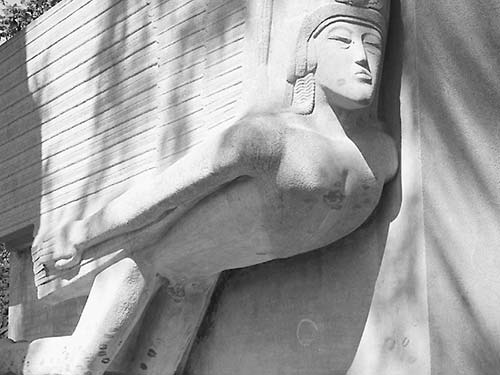
“Alas, I am dying beyond my means.”
—Oscar Wilde
• Continue along Avenue Carette and turn right (southeast) down Avenue Circulaire. You’ll walk past monuments to national airline tragedies on your left (Charm el Cheikh, a 2004 crash in Egypt killing 135 people—mostly French tourists; crashes in Venezuela, including one in 2005 that took the lives of 152 French citizens; and a flight that blew up over Niger killing 54 French in 1989). Almost two blocks down, you’ll reach Gertrude Stein’s unadorned, easy-to-miss grave (it’s the headstone with pebbles, on the right, immediately before a beige-yellow stone structure—if you reach Avenue Pacthod, you’ve passed it by about 30 yards).
While traveling through Europe, the twentysomething American dropped out of med school and moved to Paris, her home for the rest of her life. She shared an apartment at 27 Rue de Fleurus (a couple of blocks west of Luxembourg Garden) with her brother Leo and, later, with her life partner, Alice B. Toklas (who’s also buried here, see gravestone’s flipside). Every Saturday night, Paris’ brightest artistic lights converged chez vingt-sept (at 27) for dinner and intellectual stimulation. Picasso painted her portrait, Hemingway sought her approval, and Virgil Thompson set her words to music.
America discovered “Gerty” in 1933 when her memoirs, the slyly titled Autobiography of Alice B. Toklas, hit the best-seller list. After 30 years away, she returned to the United States for a triumphant lecture tour. Her writing is less well known than her persona, except for the oft-quoted, “A rose is a rose is a rose.”
Stein’s last words: When asked, “What is the answer?” she replied, “What is the question?”
• Ponder Stein’s tomb again and again and again, and continue southeast on Avenue Circulaire to where it curves to the right. Emaciated statues remember victims of the concentration camps and Nazi resistance heroes. Pebbles on the tombstones represent Jewish prayers. About 50 yards past Avenue Pacthod, veer left off the road where you see the green Avenue Circulaire street sign to find the wall marked Aux Morts de la Commune.
The “Communards’ Wall” marks the place where the quixotic Paris Commune came to a violent end.
In 1870, Prussia invaded France, and the country quickly collapsed and surrendered—all except the city of Paris. For six months, through a bitter winter, the Prussians laid siege to the city. Defiant Paris held out, even opposing the French government, which had fled to Versailles and was collaborating with the Germans. Parisians formed an opposition government that was revolutionary and socialist, called the Paris Commune.
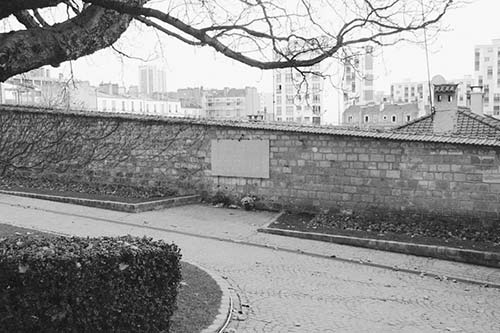
The Versailles government sent French soldiers to retake Paris. In May of 1871, they breached the west walls and swept eastward. French soldiers fought French citizens, and tens of thousands died during a bloody week of street fighting (La Semaine Sanglante). The remaining resisters holed up inside the walls of Père Lachaise and made an Alamo-type last stand before they were finally overcome.
At dawn on May 28, 1871, the 147 Communards were lined up against this wall and shot by French soldiers. They were buried in a mass grave where they fell. With them the Paris Commune died, and the city entered five years of martial law.

• Return up five steps to the road, continue to the next (unmarked) street, Avenue Transversale No. 3, and (at the Mauthausen Memorial on the right corner) turn right. A half-block uphill, Edith Piaf’s grave is on the right. It’s one grave off the street, behind a white tombstone with a small gray cross (Salvador family). Edith Gassion-Piaf rests among many graves. Hers is often adorned with photos, fresh flowers, and love notes.
A child of the Parisian streets, Piaf was raised in her grandma’s bordello and her father’s traveling circus troupe. The teenager sang for spare change in Paris’ streets, where a nightclub owner discovered her. Waif-like and dressed in black, she sang in a warbling voice under the name “La Môme Piaf” (The Little Sparrow). She became the toast of pre-WWII Paris society.
Her offstage love life was busy and often messy, including a teenage pregnancy (her daughter is buried along with her, in a grave marked Marcelle Dupont, 1933-1935), a murdered husband, and a heartbreaking affair with costar Yves Montand.
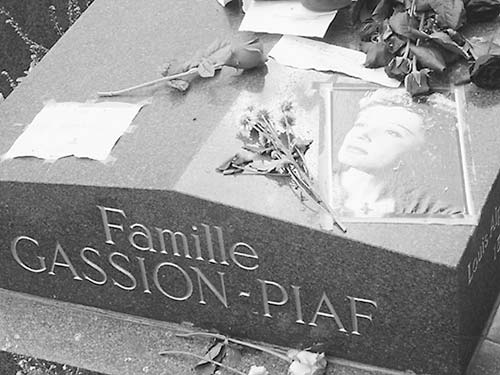
With her strong but trembling voice, she buoyed French spirits under the German occupation, and her most famous song, “La Vie en Rose” (The Rosy Life) captured the joy of postwar Paris. In her personal life she struggled with alcohol, painkillers, and poor health, while onstage she sang, “Non, je ne regrette rien” (“No, I don’t regret anything”).
• From Edith Piaf’s grave, continue uphill, cross Avenue Pacthod, and turn left on the next street, Avenue Greffulhe. Follow Greffulhe straight for roughly 80 yards until you reach a shiny black grave on the left, just beyond a grave with a huge cylindrical statue on it (10 yards before crossing Avenue Transversale No. 2).
A cartoonist for the French satirical magazine Charlie Hebdo, Tignous was one of 12 people assassinated by terrorists at the magazine’s office in January 2015. Charlie Hebdo had long attracted controversy and episodes of violence due to its inflammatory cartoons of the Prophet Muhammad. The magazine’s editor-in-chief, Stéphane Charbonnier, who also was killed in the attack, once said about their work: “We have to carry on until Islam has been rendered as banal as Catholicism.”
Look for some of Tignous’ old cartoons, as well as notes left for him, many bearing the slogan of solidarity expressed around the world: “Je suis Charlie.”
• Continue up Avenue Greffulhe (even when it narrows) until it dead-ends at Avenue Transversale No. 1. Cross the street and venture down a dirt section that veers slightly to the right, then make a hard right onto another dirt lane named Chemin Molière et La Fontaine. Molière lies 30 yards down, on the right side of the street, just beyond the highest point of this lane.
In 1804, the great comic playwright was the first to be reburied in Père Lachaise, a publicity stunt that gave instant prestige to the new cemetery.
Born in Paris, Molière was not of noble blood, but as the son of the king’s furniture supervisor, he had connections. The 21-year-old Molière joined a troupe of strolling players who ranked very low on the social scale, touring the provinces. Twelve long years later, they returned to Paris to perform before Louis XIV. Molière, by now an accomplished comic actor, cracked the king up. He was instantly famous—writing, directing, and often starring in his own works. He satirized rich nobles, hypocritical priests, and quack doctors, creating enemies in high places.
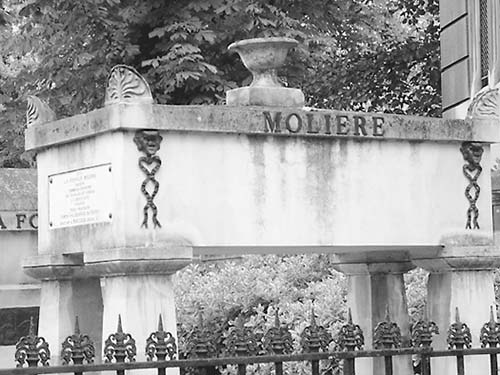
On February 17, 1675, an aging Molière went on stage in the title role of his latest comedy, The Imaginary Invalid. Though sick, he insisted he had to go on, concerned for all the little people. His role was of a hypochondriac who coughs to get sympathy. The deathly ill Molière effectively faked coughing fits...which soon turned to real convulsions. The unaware crowd roared with laughter while his fellow players fretted in the wings.
In the final scene, Molière’s character becomes a doctor himself in a mock swearing-in ceremony. The ultimate trouper, Molière finished his final line—“Juro” (“I accept”)—and collapsed while coughing blood. The audience laughed hysterically. He died shortly thereafter.
Irony upon irony for the master of satire: Molière—a sick man whose doctors thought he was a hypochondriac—dies playing a well man who is a hypochondriac, succumbing onstage while the audience cheers. Molière lies next to his friend and fellow writer, La Fontaine (1621-1695), who wrote a popular version of Aesop’s Fables.
“We die only once, and for such a long time.”
—Molière
• Continue downhill on Chemin Molière et La Fontaine (which becomes the cobbled Chemin du Bassin, bending right and ever downhill), and turn left (going steeper downhill) to where it ends on Avenue de la Chapelle. Twenty steps down, on the left, find the ticket-littered grave of Gilbert Morard, father of the Paris Métro. Add your Métro ticket and continue to the Rond Point roundabout intersection.
Cross Carrefour Rond Point and continue straight (opposite where you entered, downhill on unmarked Chemin de la Bédoyère). Just a few steps along, turn right onto Chemin Lauriston. Keep to the left at the fork (now on Chemin de Lesseps), and look (immediately) for the temple on the right with three wreaths. Jim Morrison lies just behind, often watched over by a personal security guard. You can’t miss the commotion.
Perhaps the most visited tomb in the cemetery belongs to this American rock star—lead singer for the popular band The Doors, named for the “Doors of Perception” they aimed to open. An iconic, funky bust of the rocker was stolen by fans and replaced with a more toned-down headstone. Even so, Morrison’s faithful still gather here at all hours. The headstone’s Greek inscription reads: “To the spirit (or demon) within.” Graffiti-ing nearby tombs, fans write: “You still Light My Fire” (referring to Jim’s biggest hit), “Ring my bell at the Dead Rock Star Hotel,” and “Mister Mojo Risin’” (referring to the legend that Jim faked his death and still lives today).
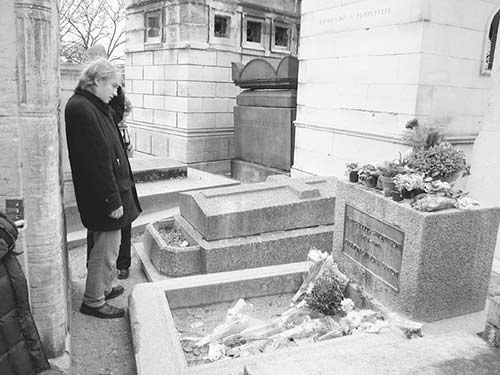
When Morrison arrived in Paris in the winter of 1971, he was famous, notorious for his erotic onstage antics, and a burned-out alcoholic. Paris was to be his chance to leave celebrity behind, get healthy, and get serious as a writer.
Living under an assumed name in a nondescript sublet apartment near Place de la Bastille, he spent his days as a carefree artist. He scribbled in notebooks at Le Café de Flore and Les Deux Magots (see here of the Left Bank Walk chapter), watched the sun set from the steps of Sacré-Cœur, visited Baudelaire’s house, and jammed with street musicians. He drank a lot, took other drugs, gained weight, and his health declined.
In the wee hours of July 3, he died in his bathtub at age 27, officially of a heart attack, but likely from an overdose. (Any police investigation was thwarted by Morrison’s social circle of heroin users, leading to wild rumors surrounding his death.)
Jim’s friends approached Père Lachaise Cemetery about burying the famous rock star there, in accordance with his wishes. The director refused to admit him, until they mentioned that Jim was a writer. “A writer?” he said, and he found a spot.
“This is the end, my only friend, the end.”
—Jim Morrison
• Return to Rond Point. The statue in the center remembers Casimir Pèrier: President of France in 1894 for only six months—shortest of any French president—he still got a big monument. Casimir is looking directly through a forest of tombstones at the tomb of Frédéric Chopin, about 50 yards away. To get there, tip-toe through the tombstones (leaving the roundabout at the Family de Valois tomb) until you hit a cobbled lane. Just to the right you’ll find:
Fresh-cut flowers and geraniums on the gravestone speak of the emotional staying power of Chopin’s music, which still connects souls across the centuries. A muse sorrows atop the tomb, and a carved relief of Chopin in profile captures the delicate features of this sensitive artist.
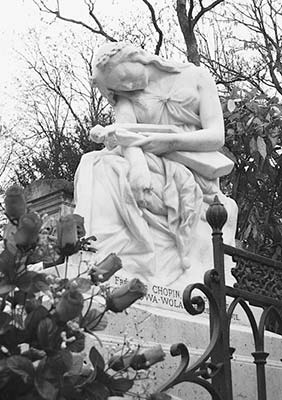
The 21-year-old Polish pianist arrived in Paris, fell in love with the city, and never returned to his homeland (which was occupied by an increasingly oppressive Russia). In Paris, he could finally shake off the “child prodigy” label and performance schedule he’d lived with since age seven. Cursed with stage fright (“I don’t like concerts. The crowds scare me, their breath chokes me, I’m paralyzed by their stares...”) and with too light a touch for big venues, Chopin preferred playing at private parties for Paris’ elite. They were wowed by his technique; his ability to make a piano sing; and his melodic, soul-stirring compositions. Soon he was recognized as a pianist, composer, and teacher and even idolized as a brooding genius. He ran in aristocratic circles with fellow artists, such as pianist Franz Liszt, painter Delacroix, novelists Victor Hugo and Balzac, and composer Rossini. (All but Liszt and Hugo lie in Père Lachaise.)
Chopin composed nearly 200 pieces, almost all for piano, in many different styles—from lively Polish dances to the Bach-like counterpoint of his Preludes to the moody, romantic Nocturnes.
In 1837, the quiet, refined, dreamy-eyed genius met the scandalous, assertive, stormy novelist George Sand (see here of the Left Bank Walk chapter). Sand was swept away by Chopin’s music and artistic nature. She pursued him, and sparks flew. Though the romance faded quickly, they continued living together for nearly a decade in an increasingly bitter love-hate relationship. When Chopin developed tuberculosis, Sand nursed him for years (Chopin complained she was killing him). Sand finally left, Chopin was devastated, and he died two years later at age 39. At the funeral, they played perhaps Chopin’s most famous piece, the Funeral March (it’s that 11-note dirge that everyone knows). The grave contains Chopin’s body, but his heart lies in Warsaw, embedded in a church column.
“The earth is suffocating. Swear to make them cut me open, so that I won’t be buried alive.”
—Chopin, on his deathbed
• Facing Chopin, walk left, uphill about 100 yards, until the lane dead ends at Avenue Laterale du Sud. Trespass straight ahead over three gravesites to the next lane and head left, downhill. About 20 steps after that lane hits the road, on the right is...
Squint through the green door. Love him or hate him, Baron Haussmann made the Paris we see today. In the 1860s, Paris was a construction zone, with civil servant Haussmann overseeing the city’s modernization. Narrow medieval lanes were widened and straightened into broad, traffic-carrying boulevards. Historic buildings were torn down. Sewers, bridges, and water systems were repaired. Haussmann rammed the Boulevard St. Michel through the formerly quaint Latin Quarter (as part of Emperor Napoleon III’s plan to prevent revolutionaries from barricading narrow streets). The Opéra Garnier, Bois de Boulogne park, and avenues radiating from the Arc de Triomphe were all part of Haussmann’s grand scheme, which touched 60 percent of the city. How did he finance it all? That’s what the next government wanted to know when they canned him.
• Four doors downhill from Haussmann is Rossini.
Dut. Dutta-dut. Dutta dut dut dut dut dut dut dut dut, dut dut dut dut dut dut dut dut...
The composer of the William Tell Overture (a.k.a. the Lone Ranger theme) was Italian, but he moved to Paris (1823) to bring his popular comic operas to France. Extremely prolific, he could crank out a three-hour opera in weeks, including the highly successful Barber of Seville (based on a play by Pierre Beaumarchais, who is also buried in Père Lachaise). When Guillaume Tell debuted (1829), Rossini, age 37, was at the peak of his career as an opera composer.
Then he stopped. For the next four decades, he never again wrote an opera and scarcely composed anything else. He moved back to Italy, went through a stretch of bad health, and then returned to Paris, where his health and spirits revived. He even wrote a little music in his old age. Rossini’s impressive little sepulcher is empty, as his remains were moved to Florence.
• Downhill ahead, on Avenue Principale, is the gate to the land of the living. But we have one more stop. Take a few steps downhill, then turn right at the corner and find the second gravesite. Here lies Colette.
France’s most honored female writer led an unconventional life—thrice married and often linked romantically with other women—and wrote about it in semi-autobiographical novels. Her first fame came from a series of novels about naughty teenage Claudine’s misadventures. In her 30s, Colette went on to a career as a music hall performer, scandalizing Paris by showing her breasts. Her late novel, Gigi (1945)—about a teenage girl groomed to be a professional mistress, who blossoms into independence—became a musical film starring Leslie Caron and Maurice Chevalier (1958). Thank heaven for little girls!
“The only misplaced curiosity is trying to find out here, on this side, what lies beyond the grave.”
—Colette
Have you seen enough dead people? To leave the cemetery, continue downhill on Avenue Principale and exit onto Boulevard de Ménilmontant. The Père Lachaise Métro stop is one long block to the right. To find the return stop for bus #69 heading west to downtown, cross Boulevard de Ménilmontant and walk downhill on the right side of Rue de la Roquette; the stop is four blocks down, on the right-hand side. Go in peace.